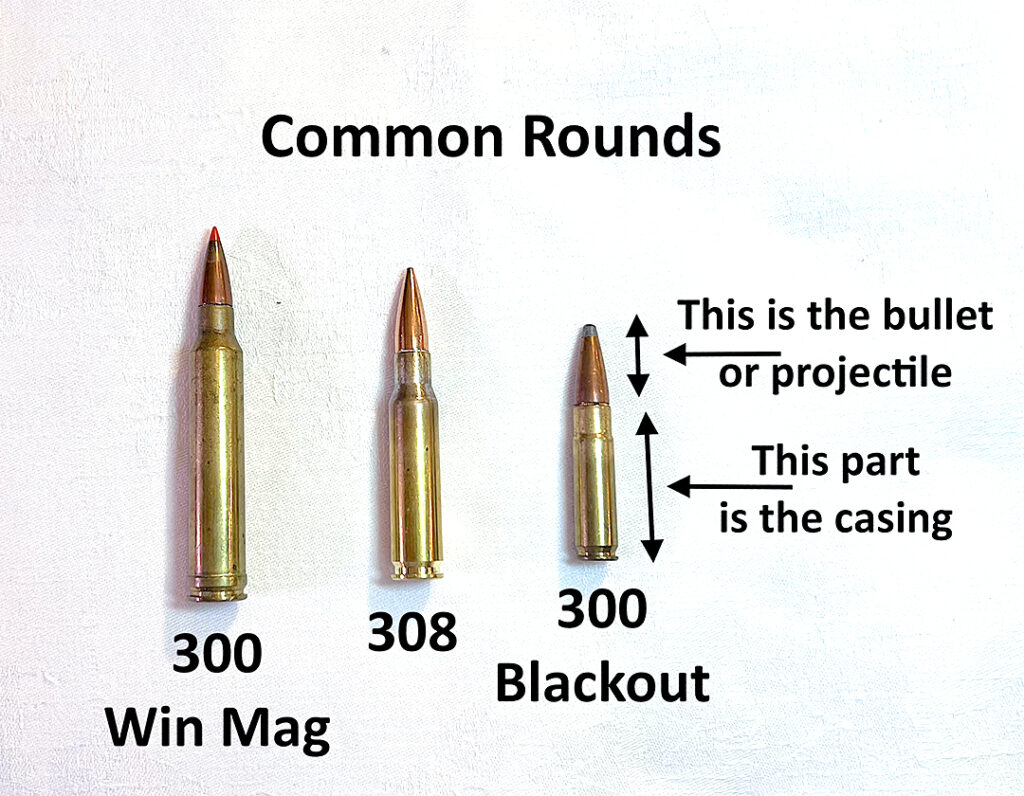Some beginning information on long guns


I don’t shoot deer. Or coyotes. I don’t even shoot snakes.
The best I’ll do is shoot an x-ring on a piece of paper. And that’s the way I like it.
But we have a lot of people in Wakulla County who shoot to get rid of nuisance animals. We have those who shoot to put dinner on the table.
During hunting season, Joe likes to get his one deer per year. That’s all it takes to make a year of breakfast sausage, summer sausage, burger patties, lasagna, tacos… well, you name it. Deer meat is lean and can be made into so many recipes.
But shoot deer myself? Absolutely not going to happen.
However, I hear Joe and friends talking about 300 Blackouts. 300 Win Mags. 308s.
OK, they’re talking rifles. Where’s the 301s? 302s? 303s? What makes a 300 a Blackout or a Winchester Mag? What about the 300s with names like: Dakota, Norma and Nosler? This is very confusing to someone who doesn’t shoot long guns.
Apparently, the 308, 300 Blackout and 300 Win Mag are common rounds. They all have the same diameter bullets: .308 inches. Now remember, a bullet isn’t what you stuff into a magazine. That object, called a round or a cartridge, is composed of a metal casing and a projectile at the end of the casing. That projectile is the actual bullet. These three rifles all have the bullet of the same diameter.
Length is a different matter. While the diameter of the projectile that fits into the casing is all the same, the lengths of these bullets can be different. However, the length of the casing is different.
Another difference is in the weight of these projectiles. Some weigh more than others. Bullet weight is measured in grains. The more grains, the more weight.
Before we go any further, Joe (and many others) want people to understand that how far a rifle is able to shoot is not necessarily the criteria for hunting deer or other game. Ethical shooting is most important.
The Armory Life suggests: “In a hunting scenario, it’s not good sportsmanship to wound your game, only leaving them to die a slow death or live the rest of their lives maimed. If you are hunting prairie dogs, .308 would be lethal easily out to a mile. However, if we are talking about shooting that medium-size North American game like a whitetail deer, the distance would be much closer. In fact, I argue that the effective range of .308 on deer is 300 yards.”
The 308 Winchester came on the commercial market in 1952. It’s quite common. Because it’s a common round, ammunition is relatively inexpensive. Common grain weights run from 150-180 grains. And, although Armory Life points out that this is best for shooting deer at about 300 yards, the 308 has been shot in competition up to 1,000 yards. But again, although the 308 is capable of long distances, an ethical shooter wants to make a clean, quick kill and not to wound the animal.
Outdoor Empire says of the 308: “…the 308 is the cheapest powerful cartridge. It’s not the most powerful on the market, no, but it has more than enough kinetic energy for almost every hunter in the United States.
“When it comes to North American animals, .308 can take any game up to moose. Though, if you’re taking such a large animal, you want the right bullet, and you better have an excellent shot placement.
“It has a big punch out to about 300 yards but starts to lose steam.
“It’s inexpensive, powerful, and fits various purposes. It’s the closest choice to a jack-of-all-trades cartridge you can buy today.”
The 300 Blackout is made for shorter-barreled rifles. According to American Arms, “the bullet fired from the 300 Blackout typically weighs 110 to 220 grains,” although “typical bullet weights for subsonic loadings are 220 grain bullets.”
Outdoor Empire opines: the “300 Blackout ammo is highly effective and legal for deer hunting in almost every state.”
When it comes to distance, our friend Wiki says: “Although you can achieve greater muzzle energy by having a longer barrel length (to build up more gas behind the bullet longer), keep in mind that 300 Blackout is designed to have an effective range of up to 300 yards at most.” Joe suggests: “An optimistic distance would be 150 yards to shoot deer.”
We’re going to discuss the 300 Win Mag next.
According to Ammunition to Go, with “bullets up to 180 grain and 3,000 feet per second (fps), 300 Win Mag Ballistics are a treasure trove of possibilities for distance shooters.”
To learn more about the Win Mag, Ammunition to Go continues: “Generally, a 300 Win Mag’s 150 grain bullet delivers a 3,260 fps muzzle velocity, while its 180 grain bullet achieves approximately 3,000 fps. It is a flat shooting cartridge, able to hit a target at 300 yards with negligible hold over.
“The 300 Win Mag retains the energy adequate to kill an elk humanely at distances greater than 600 yards. Even at 900 yards, the 300 Win Mag can pack the 1,000 ft lbs punch considered the required minimum to kill a whitetail without undue suffering. In short, this is a widely available, accurate, and powerful round that you could hunt anything with.”
In summation:
Of the 300 Blackout, the 308 and the 300 Win Mag, it seems that if you’re hunting deer, the 300 Blackout uses the lightest grain bullets (unless subsonic), and is good for hunting at shorter distances than the 308 or the 300 Win Mag.
The 308 is good for longer distances, and is accurate up to 300 yards using 150-180 grain bullets. Ammunition is readily available and not expensive.
The 300 Win Mag is accurate for longer distances up to 1,000 yards or more. It has more velocity and thus shoots flatter than the 308 or the 300 Blackout.
Of course, there are many other rifle calibers available, but these three are very commonly used to hunt deer in America.
Me, I’ll use a handgun and hunt paper.
Marj Law is the former director of Keep Wakulla County Beautiful who has become an avid shooter in retirement.


